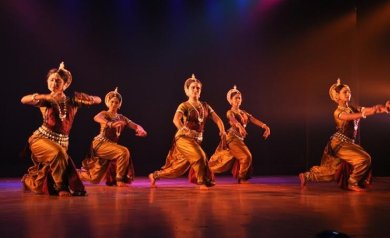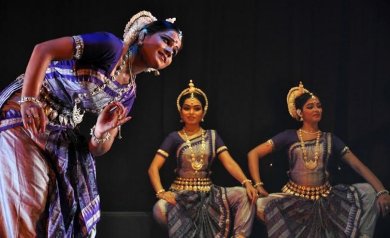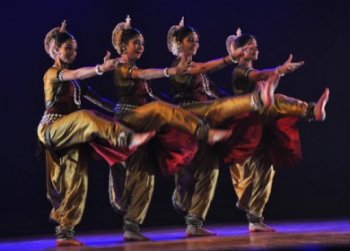
|   |

|   |
Srjan’s Kubja - Tapati Chowdhurie e-mail: tapatichow@yahoo.co.in Photos courtesy: Srjan April 25, 2016 Director of Srjan - Guru Kelucharan Mohapatra Odissi Nrityabasa – Guru Ratikant Mohapatra wears more than one hat. He is a dancer, choreographer, guru, well versed in playing Odissi mardala. He is undoubtedly a choreographer par-excellence, if one has to go by the numerous choreographic works undertaken by him one after the other. He has a unique perspective and a way of visualizing a scene to picture perfection. His love for precision connects each and every scene of his dance dramas to a panorama of events, and the rasika holds his/her breath to see its final and beautiful culmination. All his dance dramas have the perfection that one associates with Western Ballet, but in the context of Indian classical Odissi, replete with mudras and gesture language and bhavas, with just enough additions that gives it a new age direction. His group productions are not just nritta, they have stories to tell, without leaving a void on stage. The abhinaya of the main characters tell the story, while the group emotes the sthayi bhava and takes the drama forward. Many a time they fulfill the role of the narrator too - as in his Ravana, the group helped to show the development of the story, building of the bridge and other details. Together they give a spectacular picture and food for spiritual introspection. Watching his choreographic works you see a trend, which consists of not only finding a new vocabulary, but also seeing the perfection of individual movements as well as group synchronization. You see the pattern and you definitely know that a lot of thought, planning and hard work and discipline had gone into it. 
Through the language of Odissi, he tells the story of the hunch backed woman Kubja or rather the woman who carries a burden, taken from Bhagavata Purana. On the one hand she has a load on her back which she carries, which could also perhaps be translated into the burden she carries in having to be under the employment of the tyrant Kansa. Krishna frees her and her burden is taken away. Kansa pays for his life. The story has the scope of modern interpretation. Rajashri Praharaj in the role of Krishna was master of the body language of Krishna. She exuded confidence in her movements, especially when she touched Kubja’s chin which straightened her figure and turned her into a beautiful woman. Manosmita was a convincing Kubja and commended herself in the role.  Recipient of a production grant from the Ministry of Culture, Government of India, Ratikant choreographed and presented 'Vinayake Smarane' and 'Raase harimiha' from Gita Govinda along with Kubja.  'Vinayake Smarane' was in remembrance of the multiple physical attributes of Vinayaka or Ganesha using a rich vocabulary and danced with vigour and vitality. In a one-of-its-kind way ‘Raase harimiha vihita vilasam’ from Jayadeva’s Gita Govinda was choreographed. Radha’s hurt and her sorrow in reminiscing about the melodious quality of Krishna’s flute and his side-long glances of love, his playfulness and all else was done beautifully. The group movements on the stage etching geometric designs were visually magnificent. The music of Pandit Jasraj reverberated through Rabindra Mandap Hall in Bhubaneswar as it burst to the seams leaving not an inch of space. It was an evening spent in the pursuit of aesthetic bliss. Tapati Chowdurie learnt dance for almost 10 years from Guru Gopinath in his dance institution Natana Niketan in Madras. For a brief period, she was with International Centre for Kathakali in New Delhi. Tapati has a Master's degree in English Literature and Bachelor's degree in Education. She has a regular column in The Statesman, where she writes on dance and music. Presently, she is a freelance writer. |